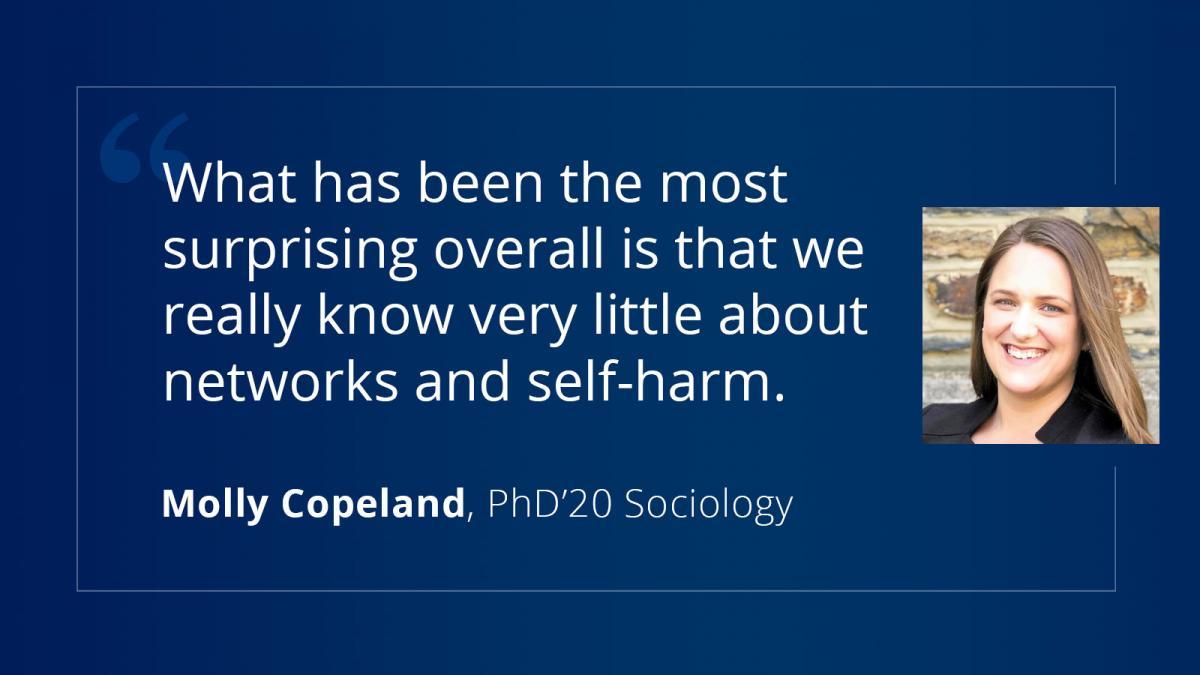
Note: This article discusses research on self-harm in adolescents.
By Jillian Daly
Duke Graduate School Communications Intern

The teenage years can be a complicated time, of awkwardness, naivety and confusion. Teens are figuring out who they are, what they’re passionate about, and who they want to be. Yet, why do some young people navigate through this turbulent time and go on to college, a career, or another healthy adult path, while others turn to unhealthy behaviors—particularly self-harm—as a means of managing their feelings?
When she was a high school teacher, Molly Copeland became interested in how the path to adulthood may be altered by one’s place in a given social network—the web of social connections linking adolescents in a setting. Now a newly minted Duke Ph.D. in sociology, Copeland is using existing data to analyze the peer networks of thousands of high school students across 27 school districts in rural Iowa and Pennsylvania.
Copeland’s research is taking the invisible—yet present—peer networks of adolescents and mapping them into tangible relationship webs to see how one’s position in a given web affects their mental health and behavior over time, as well as what drives whether or not they are led to self-harming thoughts or actions.
“We pay so much attention to how something like peer pressure might matter for smoking cigarettes or other behaviors that are visible,” Copeland said, “but is this something that also applies to mental health?”
Part of Copeland’s research looks at students’ answers to questions regarding mental health through all four years of high school. This information helps her physically map and visualize the unspoken rules and social structures that affect adolescent behavior.
“I think what has been the most surprising overall is that we really know very little about networks and self-harm,” she said. “Even when we net out other kinds of mental health characteristics, like depression, we still see an association between network features and self-harm.”
Self-harm, which Copeland describes as “any intentional harm to one’s body or body tissue,” is a behavior that many adolescents may turn to when they are struggling to manage their feelings, or in times where they feel so many depressive symptoms that they inflict physical harm just to “feel something,” Copeland said.
It is a popular conception that self-harm is something that is done by an outcast, someone who feels they are shut out from their peers and do not belong in any social network. However, Copeland’s research has shown that adolescents of all genders and complex social roles are exhibiting self-harmful behavior. In cases where one’s friends are contributing to their stress, or participating in self-harmful behaviors themselves, an adolescent may be even more at risk.
Network features can include characteristics like a student’s position in the social network of their grade as a whole, or their position within a specific social circle or friend group. Copeland said her research suggests that there are social patterns, issues, and expectations among adolescents that go beyond merely managing feelings. While these factors are not yet fully understood, research like hers is making the progress needed to support adolescents in their transitions to adulthood.
“One of the biggest takeaways is really that I hope that this research trickles down into policy or education training so that people know that self-harm is a very serious mental health concern,” said Copeland, who will be an assistant professor in the Department of Sociology at Michigan State University in the fall. “It is affecting a substantial portion of adolescents, and it happens for both boys and girls.”